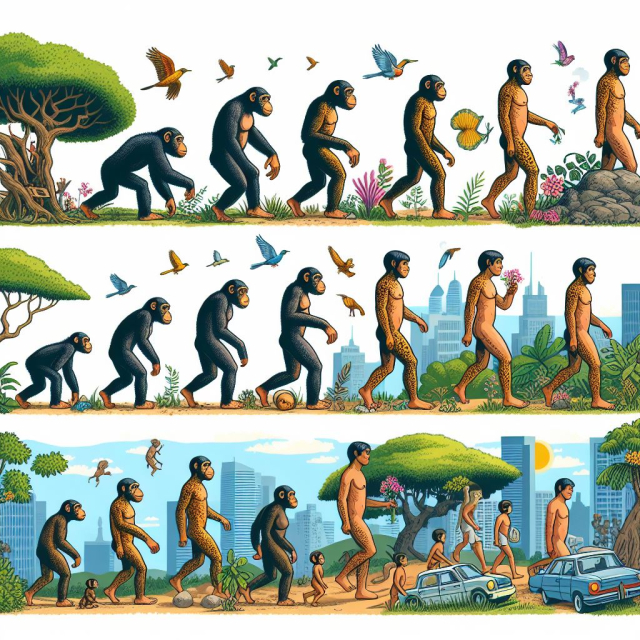Human evolution is one of the most fascinating and complex stories in biology. From our earliest ancestors to modern Homo sapiens, the process of evolution has been long and full of impressive discoveries that help us better understand who we are and where we come from. This article will explore major milestones in human evolution, highlighting scientific advances that have illuminated our past.
The First Ancestors: Australopithecus.
The story of human evolution begins approximately 7 million years ago, when the first hominids separated from the common ancestors we shared with chimpanzees. One of the oldest genera in the fossil record is Australopithecus.
Australopithecus afarensis.
One of the best known is Australopithecus afarensis, represented by the famous fossil called "Lucy." Lucy lived about 3.2 million years ago in what is now Ethiopia. Australopithecus had mixed characteristics: although they walked upright on two legs, their brains were still small, similar to those of chimpanzees. This bipedalism is one of the key traits that distinguish hominids from other primates.
The Transition to Homo: Habilis and Erectus.
The genus Homo represents a significant advance in human evolution, characterized by an increase in brain size and the use of more complex tools.
Homo habilis.
Homo habilis, which lived approximately 2.4 to 1.4 million years ago, is one of the first species of the genus Homo. Their fossils show an increase in brain size and evidence of the use of stone tools. This use of tools marks an important milestone in cognitive ability and adaptation to different environments.
Homo erectus.
Homo erectus, who lived between 1.9 million and 110,000 years ago, is notable for several reasons. It was the first species to have body proportions similar to those of modern humans, with longer legs and a more upright posture. It was also the first to leave Africa, expanding throughout Europe and Asia. Homo erectus used more advanced tools and may have controlled fire, which would have been crucial for cooking food and keeping warm in colder climates.
Neanderthals and Homo Sapiens.
One of the most intriguing chapters in human evolution is the coexistence and eventual replacement of Neanderthals by Homo sapiens.
Homo neanderthalensis.
Neanderthals (Homo neanderthalensis) lived in Europe and western Asia from approximately 400,000 to 40,000 years ago. They were well adapted to the cold climate of the Ice Age and had a robust and strong body. Their brains were as large, or even larger, than those of modern humans, and there is evidence that they practiced rituals and buried their dead, suggesting significant cultural complexity.
Homo sapiens.
Modern humans (Homo sapiens) appeared in Africa about 300,000 years ago. They are characterized by a more rounded skull and a large brain. Homo sapiens began displaying complex behavior much earlier than originally thought, creating art, sophisticated tools, and personal adornment. They migrated out of Africa in several waves, replacing or mixing with other human species such as Neanderthals.
Interaction between Homo sapiens and Neanderthals.
One of the most fascinating discoveries is that Homo sapiens and Neanderthals not only coexisted, but also interbred. This has been confirmed by genetic studies showing that all non-African humans have between 1% and 2% Neanderthal DNA. This genetic mixing indicates that there was significant contact between these two human species.
Key Factors in Human Evolution.
Bipedalism.
The development of bipedalism was a crucial step in human evolution. Walking on two legs freed the hands, allowing the manipulation and use of tools, and made it easier to transport food and offspring. This change may also have influenced the development of a larger brain by allowing for greater energy efficiency.
Brain Development.
Throughout evolution, the human brain has increased significantly in size. This brain growth allowed the development of advanced cognitive abilities, such as problem solving, long-term planning, and the use of language. Increased brain size also correlated with dietary changes, such as meat consumption, which provided the calories and nutrients needed to maintain a large, active brain.
Tools use.
The use and manufacture of tools is a defining characteristic of the genus Homo. From the simple stone tools of Homo habilis to the advanced weapons and utensils of Homo sapiens, the ability to create and use tools has been essential for survival and evolutionary success. The tools allowed humans to access a wide range of foods, defend themselves from predators, and build shelters.
Language and communication.
The development of language and the ability to communicate complexly is another key factor in human evolution. Although there are no fossils that can directly reveal when language began, advanced communication capabilities allowed humans to coordinate activities, share knowledge, and transmit cultural information. This has been fundamental for the construction of complex societies and the accumulation of knowledge over generations.
Human Evolution in the Modern Context.
Genetics and DNA.
Modern genetics has revolutionized our understanding of human evolution. Analysis of ancient and modern DNA has provided detailed information about the migration, mixing and adaptation of human populations. These techniques have allowed scientists to trace human lineages and better understand current genetic diversity.
Advances in Archeology.
Advances in archaeology, including dating technology and more precise excavations, have revealed new fossils and artifacts that continue to fill the gaps in our understanding of human evolution. Each discovery contributes crucial pieces to the puzzle of our past.
Modern Adaptations.
Human evolution has not stopped; Modern humans continue to adapt to their environment. Changes in diet, disease resistance, and cultural adaptations are examples of how evolution continues to influence our species. Adaptability and ingenuity remain key factors in our survival and success.
Human evolution is a constantly developing narrative, enriched by scientific discoveries and the advancement of technology. From the earliest hominids to modern Homo sapiens, humanity's journey is marked by physical, cognitive, and cultural adaptations that have allowed our species to thrive in a variety of environments. As we continue to explore our past, each new discovery brings us closer to understanding the complex and fascinating story of human evolution.
